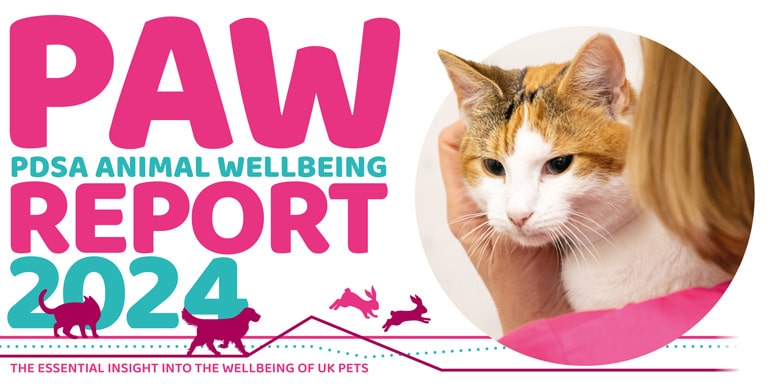Cats
91% of owners told us owning a cat improves their life, 51% say it makes them physically healthier, and 88% say it makes them mentally healthier. However, only 15% of cat owners had heard about the 5 Welfare Needs, lower than dog (18%) or rabbit (35%) owners.
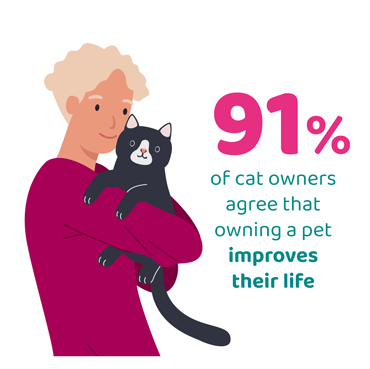
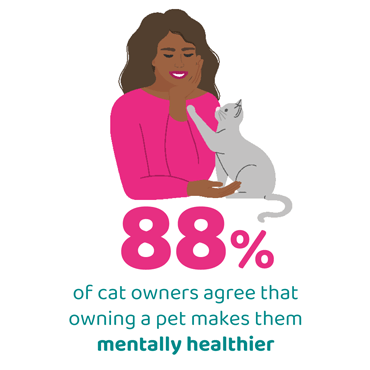
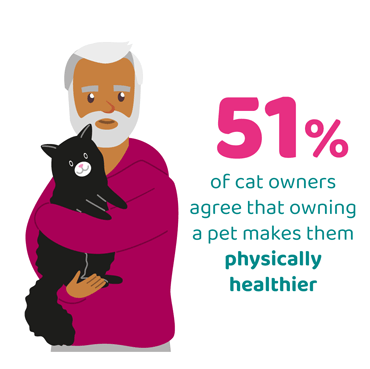
Companionship
84% of owners told us they felt informed about their cat’s need for companionship, which was lower than dog owners at 89% and rabbit owners at 94%.
Cats are territorial animals and can find it stressful to live alongside another cat. In 2024, 58% of pet cats in the UK live alone. 42% live with another cat, comprising of 25% who live with one or more cats they enjoy being with, and 17% who live with one or more other cats they don’t always get along with, meaning 1.8 million cats are potentially stressed by their living companion. There has been very little change in these proportions since 2017.
Cats living in multi-cat households, whether their owner feels they get on together or not, are more likely (55%) to show one or more behaviours that could be indicative of stress* compared to those living alone (48%). Unsurprisingly, cats living with one or more cats they don’t get on with (67%) are more likely to show one or more of these stress-related behaviours* compared to either those living with cats they do get along with (47%) or those living alone (48%).
Cats may find it less stressful to live alongside each other if they are introduced to a new home at the same time, rather than moving into a territory that has already been established by another cat. We asked owners of more than one cat when their pet was acquired. In multi-cat households, owners who acquired their other cat(s) at the same time were more likely (68%) to say their cat lived with one or more cats they got on with, than owners who already had cats (53%) or who have acquired other cats since (55%). Similarly, owners who acquired their cats at the same time were less likely to say their cat didn’t get on with the other cats they lived with (32%) compared to those who already had cats (47%) or subsequently acquired other cats (45%).
Cats in households where other cat(s) had been added since they were acquired are more likely to show one or more of the above behaviours which could be indicative of stress* (63%) compared to those where there were already cats in the household (52%) or where other cats were acquired at the same time (51%). Cats in households where there were already cats are more likely to show none of the behaviours listed** (27%) compared to those where cats have been acquired since (20%), but there was no difference to those who were acquired at the same time. This seems to suggest that introducing a cat into a household may be more stressful for any cats already present than it is for the new cat.
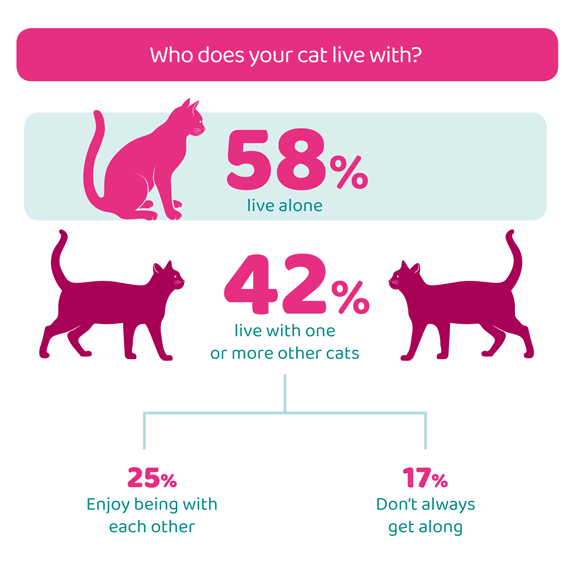
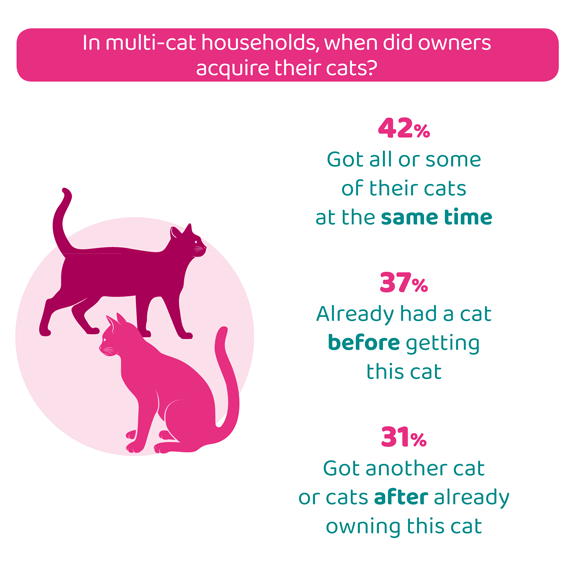
Environment
95% of cat owners told us they felt informed about how to provide their cat with a suitable environment which was less than dog (96%) and rabbit owners (98%).
Two thirds of cats (67%) currently have access to both indoor and outdoor environments, decreased from 70% in 2022, while 31% live indoors only, increased from 28% in 2022, and 1% live outdoors only. The proportion of cats who live solely inside has been steadily increasing since 2011, when only 15% of cats lived indoors only and 83% both indoors and outside.
Of those cats whose owner told us they had access to both the indoor and outdoor environment, 70% can come and go as they choose, 31% are shut inside at certain times of the day or night, 17% have the option to go outdoors but choose to stay indoors, 8% are shut outside at certain times of the day or night and 8% have access to the outdoors but it is either cat-fenced or a catio (i.e. outdoor cat enclosures like patios for cats).
It can be harder for owners to meet all their cat’s needs with an indoor only environment, which can result in stress and unwanted behaviours22. However, we found no difference in the proportion of cats showing one or more behaviours indicative of stress* for indoor only cats (48%) compared to cats living both indoors and outdoors. There are also significant health risks for cats outside, including fights with other cats and road traffic accidents23. Of those cats who live indoors only, 57% do so because their owner thinks it’s unsafe for them to be outside and 11% of owners said their cat lives indoors for health reasons. 20% of indoor only cats have the option to go outside but choose to live indoors.
Using cat proof fencing or so-called ‘catios’ can allow cats the benefits of an outdoor environment while minimising the risks. 10% of cats whose owners told us they live indoors have access to an outside area that is fenced with cat proofing fencing to keep them in and 8% have access to a catio but don't go anywhere else outside.
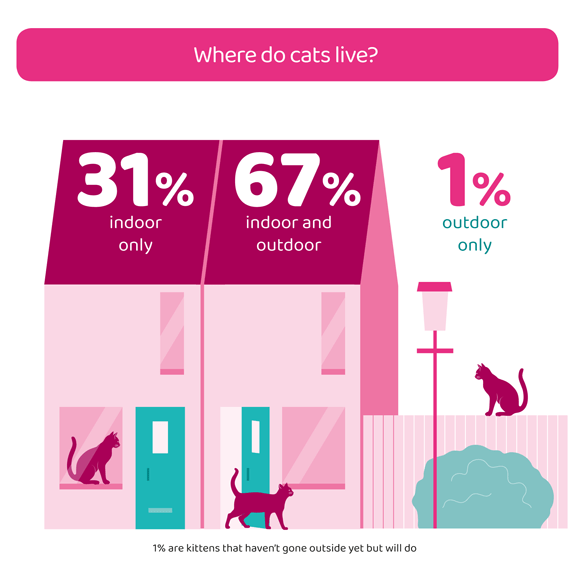
Having access to the outdoors could potentially improve cats’ ability to get along with other cats they live with by giving them the opportunity to avoid each other if wanted. However, cats who live with one or more cats they don’t get on with are actually less likely to be indoors only (24%) and more likely to be indoors and outdoors (73%) compared to those who live with other cat(s) they get on with (34% and 63% respectively). One explanation could be that if owners find their cats don't get along together, they give them more space by allowing access to the outside.
Resources
Adequate provision of resources is extremely important to help cats live alongside each other harmoniously. It is recommended practice to provide one of each resource per cat plus one extra24, spread out around the house to allow cats their own space and the opportunity to avoid each other if they wish to. Unfortunately, as we have found in previous years, many households still provide an inadequate number of resources for their cats. 87% of multi-cat households have two or less litter trays (including 21% who have no litter trays and 40% who have one litter tray), 67% have 2 or less cat beds and 77% have two or less scratching posts.
22% of cats have no litter tray at all, equating to 2.4 million cats, including 2% of indoor only cats. Even cats who toilet outside should have access to an indoor litter tray, in case they are unable to access the outdoors for any reason such as injury or bad weather.
Cats have very specific behavioural needs when it comes to litter trays25. If their needs are not adequately met, it can result in inappropriate elimination around the home, which risks damaging the bond between cats and their owner. Litter trays should ideally be placed in quiet areas of the home26, so cats feel safe when using them, 60% of owners who gave their cat litter tray(s) told us they did this. However, 20% of trays were placed by a doorway to the outside, which could lead a cat to feel unsafe using the litter tray and therefore look for other places in the home to toilet. Litter trays should also be placed in different areas of the home, particularly important for multi-cat households so cats are able to use a litter tray away from other cats. 45% of owners of more than one cat told us their litter trays are placed in various locations around the home, but 27% are placed together in the same place.
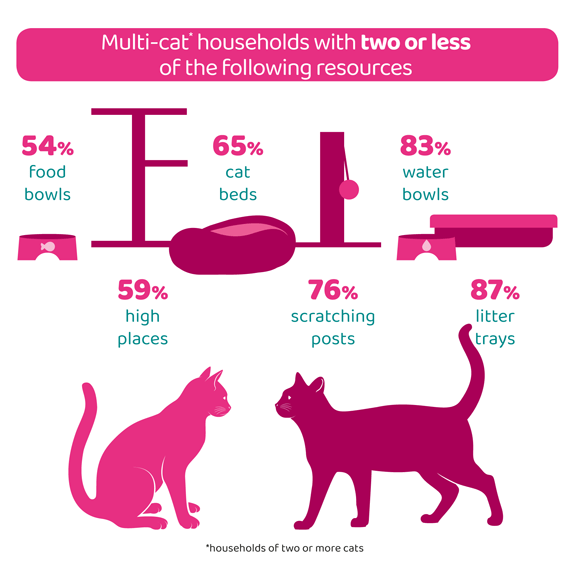
Behaviour
34% of owners told us that their cat scratches inappropriate items such as furniture, doorframes or carpets. Scratching is a normal and fundamental behaviour for cats which helps them to maintain their claw condition and to communicate27, so it is important they have the ability to exhibit this behaviour on objects that are acceptable for their owner. Where a cat chooses to scratch28 will depend on individual preferences, what scratching resources they have, and accessibility. Interestingly there is no difference in the proportion of cats who scratch inappropriate items in households with no scratching posts compared to those with one or more scratching posts. It is possible that the scratching posts provided are not in a suitable place or of a suitable texture for their cat.
Scratching can be a way for a cat to mark their territory, and some cats will scratch as a result of stress29, such as could be caused by living with another cat. However, we did not find an association between this behaviour and the presence of other cats within the home compared to cats living alone, although cats in households where other cats were acquired at the same time are more likely to scratch inappropriate items (37%) compared to those where cats were acquired since (30%). There was no difference when compared to those where there were already cats in household.
9% of cats toilet in the house away from the litter tray and 7% close to the litter tray but not in it. Cats living with one or more cats are more likely to toilet in the house away from the litter tray (11%) than cats living alone (7%). In multi-cat households, indoor only cats are more likely (22%) to show inappropriate elimination (toileting close to the litter tray but not in it or somewhere else in the home), compared to 13% of indoor and outdoor cats.
In multi-cat households, cats are more likely to display inappropriate elimination behaviours, such as toileting somewhere else in the house (away from the litter tray), when litter trays are placed together (18%) rather than not (11%), litter trays are not spot cleaned daily (19%) compared to when they are (9%), and when they contain scented litter (21%) compared to when they do not (11%). These results show how important it is to consider litter tray placement and management when investigating causes of inappropriate elimination. Interestingly, there was no difference in the proportion of cats showing this behaviour between cats who live alone or with one or more other cats.
Cats have a behavioural need to display hunting or predatory behaviour30. 52% of owners told us their cat plays with toys in a predatory way by themselves, and 50% play with toys in this way with their owner. Younger cats (0-4 years old) were more likely to show predatory behaviour through play (83%) compared to those who are 5-12 years old (77%) or over 12 years old (61%). These younger cats are also less likely to prey on wildlife (33%) compared to those who are 5-12 years old (42%), although still higher than cats over 12 years of age (27%).
"The trend for more cats living solely indoors, documented by the PAW Report over the last 14 years as increasing from 15% to 31%, raises some concerns. Whilst some cats can live very successfully as indoor only pets and there are strong safety arguments for keeping cats indoors, the suitability of the cats for this and the ability of the owner to meet their needs is highly individual and variable. The complete lack of litter tray provision for 2% of indoor cats (78,000 cats) is especially of concern and highlights the importance of continued education on feline environmental needs for cat owners.’"
Nathalie Dowgray, BVSc, MRCVS, MANZCVS, PGDip, PhD Head of ISFM
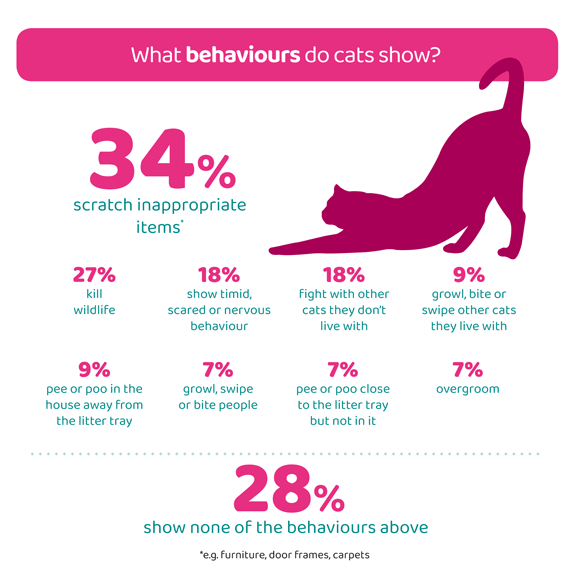
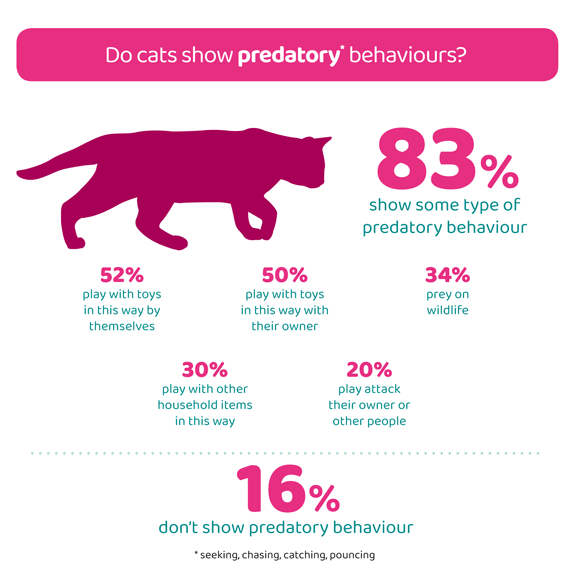
Preventive health
As in previous years, we found that fewer cats have had each of the preventive healthcare options than dogs, except for neutering, which was higher than dogs, and treated for fleas, which showed no difference from dogs.
87% of cats are neutered, 9.4 million cats, proportionally more than dogs (68%) and rabbits (61%). We have seen the level of neutering in cats fluctuate over the years and whilst the current level is unchanged from 2023, it is slightly lower than the average over the last eight years (89%). The most common reasons owners gave for not neutering their cat was because they don’t go outside (18%), are too young (14%) or because it’s too expensive (13%, unchanged from 2023).
PDSA is part of CatKind, who over many years have developed collaborative campaigns across the animal welfare sector and veterinary professions to encourage the neutering of cats at four months to reduce the risk of accidental pregnancies in these young females. 4% (190,000 cats) had their first litter at under six months old, which this initiative would prevent. In addition, 10% of owners cannot recall when their cat had their first litter, so it is possible that the true proportion of cats who had their first litter under six months old is higher.
65% of cats have regular booster vaccinations, 7 million cats, which is no different from 2023. The proportion of cats receiving regular boosters has fluctuated over the years but in 2024 is higher than the average since 2017 (61%). The most common reasons owners gave for not having cats vaccinated were it’s too expensive (19%), their cat doesn’t go outside (16%) or doesn’t come into contact with other animals (11%) - these reasons were also the top findings in 2023.
The proportion of cats in the UK who are microchipped has increased steadily from 64% in 2017 until 2021 when it was 77%. In 2024, 78% of cats are microchipped which is no different from 2021 or 2022 but is higher than 2023 (75%). On 10 June 2024, legislation31 will be introduced in England, making it compulsory to microchip all pet cats over the age of 20 weeks. 78% of pet cats in England are currently microchipped, meaning approximately 2.4 million pet cats will require a microchip before the legislation is in force. Only 44% of cat owners in England said they were aware that cats must be microchipped after 10 June 2024, although this has increased from 28% in 2023. The most common reasons owners gave for not having their cat microchipped were that their cat doesn’t go outside (21%), is unlikely to stray (17%) and they don’t think it’s necessary (16%).
45% of cats are insured, higher than in 2023 (39%) but still lower than dogs. This is a positive finding, although 4% of cat owners also told us they are cancelling their pet insurance due to the cost of living so that they can continue to care for their pet. The most common reasons owners gave for not having cats insured were that it is too expensive (43%), they save money for vet bills instead (24%) and they don’t think they will get their money’s worth (23%).
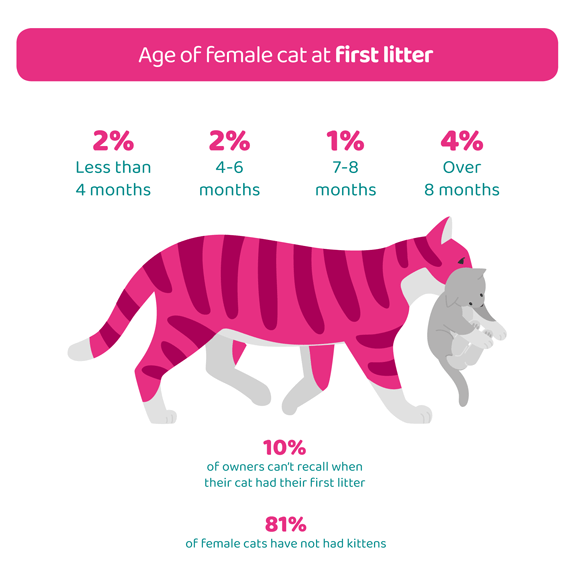

Similarly to the findings in dogs, of the 77% of owners who have treated their cat for worms, 95% are doing so preventively and 92% of the 83% of cat owners who are treating their pet for fleas are doing it for preventive reasons. A higher proportion of cat owners are treating for fleas due to an active infestation (5%) compared to dog owners (3%). It is also interesting to note that the proportion of owners who are treating their cat or dog for fleas is comparable, whereas all other preventive healthcare options*** (apart from neutering) are lower in cats. This could demonstrate that fleas are considered to be more of an issue in cats than dogs.
Cat owners were more likely than dog owners to get their flea and worming products from on online pharmacy without a prescription (15% compared to 10%) and less likely to get from a veterinary practice (57% compared to 63%).
Cost of living
22% of cat owners (2.4 million cats) say the cost of living has affected how they care for their pet, with 10% of owners changing to a cheaper cat food and 4% cancelling their pet insurance. While these proportions have not changed significantly since 2023, it remains a worrying level of owners who are struggling with the financial realities of owning a pet. 89% of cat owners agree the cost of owning a pet has increased.
31% of cat owners have made personal cost saving decisions in order to care for their pet, with 16% giving up luxuries for themselves, 14% making savings on their weekly food shop and 11% reducing energy consumption. As we also found with dogs and rabbits, these proportions remain similar or slightly decreased to 2023, however it is clear that the currently high costs of living continue to affect a notable proportion of cat owners.
Key findings about cats from our 2024 PAW Report
 Video found at youtu.be/8YAu6saz72w
Video found at youtu.be/8YAu6saz72w

Footnotes
* Growling / swiping / biting people, growling / swiping / biting other household cats, missing the litter tray when peeing / pooing, peeing / pooing somewhere else in the house (away from litter tray if one available), timid / scared / nervous behaviour, overgrooming, fighting with other cats they don’t live with.
** Growling / swiping / biting people, growling / swiping / biting other household cats. missing the litter tray when peeing / pooing, peeing / pooing somewhere else in the house (away from litter tray if one available), timid / scared/ nervous behaviour, overgrooming, killing wildlife, fighting with other cats they don't live with, scratching inappropriate items (e.g. furniture, door frames, carpets).
*** Neutered, vaccinated - primary course (when young), vaccinated - regular boosters, microchipped, insured, wormed, treated for fleas, currently registered with a vet
22 Foreman-Worsley, R., & Farnworth, M. J. (2019). A systematic review of social and environmental factors and their implications for indoor cat welfare. Applied Animal Behaviour Science, 220, 104841.
23 Tan, S. M., Stellato, A. C., & Niel, L. (2020). Uncontrolled outdoor access for cats: An assessment of risks and benefits. Animals, 10(2), 258
24 Ellis, S. L., Rodan, I., Carney, H. C., Heath, S., Rochlitz, I., Shearburn, L. D., ... & Westropp, J. L. (2013). AAFP and ISFM feline environmental needs guidelines. Journal of feline medicine and surgery, 15(3), 219-230
25 Grigg, E. K., Pick, L., & Nibblett, B. (2013). Litter box preference in domestic cats: covered versus uncovered. Journal of feline medicine and surgery, 15(4), 280-284.
26 Rochlitz, I. (2009). Basic requirements for good behavioural health and welfare in cats. In BSAVA Manual of canine and feline behavioural medicine (pp. 35-48). BSAVA Library.
27 DePorter, T. L., & Elzerman, A. L. (2019). Common feline problem behaviors: Destructive scratching. Journal of feline medicine and surgery, 21(3), 235-243.
28 Zhang, L., & McGlone, J. J. (2020). Scratcher preferences of adult in-home cats and effects of olfactory supplements on cat scratching. Applied Animal Behaviour Science, 227, 104997
29 Tateo, A., Zappaterra, M., Covella, A., & Padalino, B. (2021). Factors influencing stress and fear-related behaviour of cats during veterinary examinations. Italian Journal of Animal Science, 20(1), 46-58.
30 Cecchetti, M., Crowley, S. L., & McDonald, R. A. (2021). Drivers and facilitators of hunting behaviour in domestic cats and options for management. Mammal Review, 51(3), 307-322.
31 Microchipping of Cats and Dogs (England) Regulations 2023

